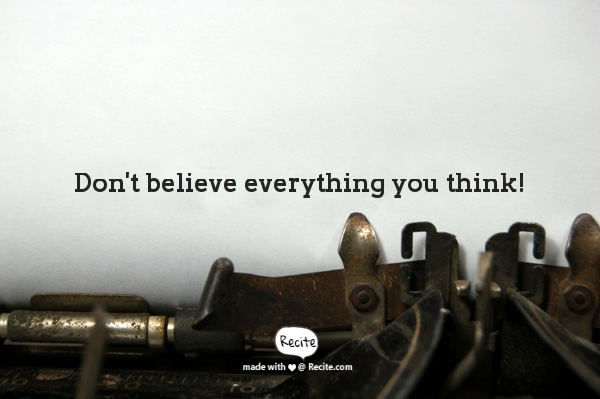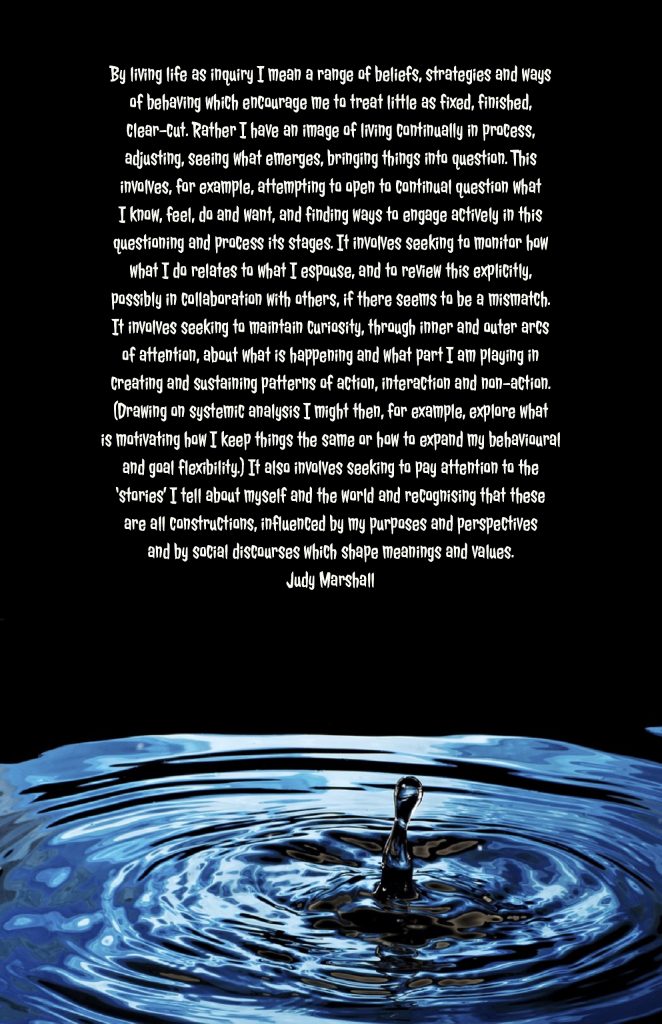
I have just spent my last morning before spring break reading blog posts from you all. I wish the wisdom and engagement with learning could be ‘out here’ on the web for others to learn from rather than ‘in there’ jailed inside Blackboard.
I have been touched by what you have written, I feel privileged to have been given a window into the many creative ways you have taken on challenging reading and found ways to turn them into life experiments that could enable you embed the teaching into your daily lives. Living life as inquiry is a challenging choice to make in learning, it would be so much easier to just quote page numbers and apply only logical thought to what you are all reading.
Judy Marshall has written a whole book about living life as inquiry as a research method, a handbook for first person action inquiry. Her original definition of the process came vividly to mind on reading your wonderful words this morning, and bears quoting in full (and I hope close reading on your part),

The original paper describes the process in such a way that it can enable us to embed within it any approach to action inquiry. I was struck by the diversity with which you tackled the ‘making sense’ of our content: one of you thinking of our authors as long lost grandparents, or picking out imagery the authors use in a short sentence and connecting to personal learning, or expressing honestly how challenging certain readings have been.
Something that stood out for me as a theme was that you are understanding the importance of intentional cognitive friction to learning new things. The way in which challenge and discomfort can bring us new insight but also how tough it is to sit with feelings we label as negative.
Another theme that jumped out at me, about the learning process, was how much of a prerequisite to learning intention is. You all worked with the Daily Stillness and, as it had been set as an assignment, you ‘took the prompt with you’ for the day. Some of the stories you told about the impact I found touching and one in particular made me stop and think: one of you had kept a prompt for 6 weeks, waiting for time to ‘do it’ and decided to use the video in the prompt as quiet time each morning through the week instead of working with new prompts. This made me reflect on how important it is for us to prioritise inquiry in life. The idea of taking time to watch a soothing video that could enhance my wellbeing, remains just an email in my inbox unless I prioritise taking action on this email above the many other things demanding my attention. In a sense, what matters most is to decide that it matters.
Several of you spoke about ‘small activities’ making a big difference to the ongoing quality of your experience. One of you feeling finally ‘liberated from the cell phone’ after choosing to create a blank screen for it, so that they could relate to it intentionally: Am I acting from habit or do I want to check the phone? Again, this was a prompt that had been on the inbox for a while, but this week it was time for action. Liberation indeed, as you wrote on your post. I am always surprised at the big impact that a small thing can have, if we choose to commit to do it and turn it into an opportunity for personal inquiry. Of course, what this means is monitoring the results we get, but not judging those results. We note that we could or could not do it. We note that we can start again the next day or the next moment. We note, we let go and frame the next inquiry. This is what John Peacock defines as the epistemology of Buddhism: Orthopraxis.
Another theme that stood out was the strong positive or negative reactions that this week’s Movie Week generated. Words like: ‘unhelpful and depressing’ applied to the same video that somebody else sees as ‘a lighthearted look at alienation, modern dystopian living, and the collapse of our species’; another video seen as ‘hectic and loud’ by one, and ‘fun and inspiring’ by somebody else. I thought this an example of how asynchronous communication can teach us, if we give meditated text a chance. We have been talking about how our proliferating views and opinions stop us from opening to experience and something as simple as reacting to a short animation can show us how “We see things not as they are, but as we are.” Unknown

Or, more colloquially expressed by a popular meme – don’t believe everything you think!
Thank you all so much for taking the time to engage with our learning lab, for taking on the challenge to apply the ideas to your daily lives and for bringing a beginner’s mind to the results you are encountering as you inquire.
